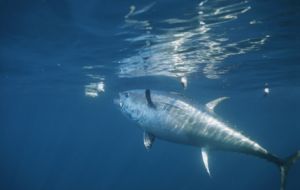MercoPress. South Atlantic News Agency
China and Peru top world list of fish tonnage caught, says National Geographic
 A large tuna must eat the equivalent of its body weight every 10 days to stay alive
A large tuna must eat the equivalent of its body weight every 10 days to stay alive China leads the world in tonnage of fish caught annually as well as the amount of fish consumed, according to new findings reported in National Geographic magazine.
The research, conducted by the University of British Columbia in collaboration with the National Geographic Society and The Pew Charitable Trusts, ranks the top 20 nations that have the greatest impact on ocean ecosystems through catching or consuming marine wildlife.
China's top ranking results from its enormous population, despite its very low per capita footprint of fish catch and consumption. Japan is high on the list too, a result of its rate of consumption (often by importation) of fish rather than its catch. The “top 20” lists of fish catch and consumption are unveiled in the October issue of National Geographic magazine.
The United States comes in third in both lists, due to its relatively large population and tendency to eat top predator fish such as Atlantic salmon. Peru ranks second in the world in catch though are not in the top 20 fish-consuming countries because Peruvians on the whole eat little seafood.
The data come from the SeafoodPrint study, led by Daniel Pauly of the University of British Columbia and National Geographic Ocean Fellow Enric Sala.
In assessing the true impact nations have on the seas, the team needed to look not just at what a given nation caught but also at what the citizens of that nation ate. Standard methods of measuring nations' impact on the sea are misleading because, as Pauly says, “every fish is different. A pound of tuna represents roughly a hundred times the footprint of a pound of sardines.”
That's because fish like tuna are apex predators — they feed at the very top of the food chain. The largest tuna eat enormous amounts of fish, including intermediate-level predators such as mackerel, which in turn feed on fish like anchovies, which prey on microscopic organisms. A large tuna must eat the equivalent of its body weight every 10 days to stay alive, so a single thousand-pound tuna might need to eat as many as 15,000 smaller fish in a year, the National Geographic article says.
Any large fish in the world — a Pacific swordfish, an Atlantic mako shark, an Alaska king salmon, a Chilean sea bass — is likely to depend on several levels of a food chain.
The SeafoodPrint method provides a way to compare all types of fish caught, by creating a unit of measurement based on “primary production” — the microscopic organisms at the bottom of the marine food web — required to make a pound of a given type of fish. The research found that a bluefin tuna, for example, may require a thousand pounds or more of primary production.
“The SeafoodPrint allows us to directly compare a sardine fishery with a tuna fishery, because each is measured according to the primary production it represents,” Pauly says.
The new approach also allows the researchers to assess individual nations' impacts on the seas, based not only on what was caught but also on what their citizens ate through imports. “A country can acquire primary production by fishing, or it can acquire it by trade,” says Pauly, whose research is part of the Sea Around Us project of The Pew Charitable Trusts and the University of British Columbia.
Much of the world's catch, especially from the high seas, is being purchased by wealthy nations for their people; poorer countries simply can't afford to bid for high-value species, the article says. Citizens in poor nations also lose out if their governments enter into fishing or trade agreements with wealthier nations. In these cases, local fish are sold abroad and denied to local citizens — those who arguably have the greatest need to eat them and the greatest right to claim them.
Humanity's demand for seafood has now driven fishing fleets into every virgin fishing ground in the world, the scientists say. A report by the World Bank and United Nations' Food and Agriculture Organization suggests that even if the number of boats, hooks and nets now used were cut by half, the world would still end up catching too many fish to be sustainable for the future.
The scientists favour treaties among nations setting seafood-consumption targets as well as ocean havens to safeguard resources. “Barely one percent of the ocean is now protected, compared with 12 percent of the land,” Sala says, “and only a fraction of that is fully protected.”
The National Geographic Society, the Waitt Foundation and the SEAlliance, along with strategic government, private, academic and conservation partners including the TEDPrize, Google and IUCN, are beginning an action-oriented marine conservation initiative under the banner of “Mission Blue” that will increase global awareness of the urgent ocean crisis and help to reverse the decline in ocean health by inspiring people to care and act; reducing the impact of fishing; and promoting the creation of marine protected areas. For more information, go to www.iamtheocean.org.




Top Comments
Disclaimer & comment rulesCommenting for this story is now closed.
If you have a Facebook account, become a fan and comment on our Facebook Page!